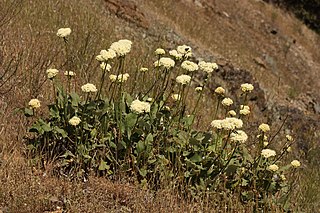
Eriogonum is the scientific name for a genus of flowering plants in the family Polygonaceae. The genus is found in North America and is known as wild buckwheat. This is a highly species-rich genus, and indications are that active speciation is continuing. It includes some common wildflowers such as the California buckwheat.

Eriogonum nudum is a perennial shrub of the wild buckwheat genus which is known by the common name naked buckwheat or nude buckwheat.

Eriogonum fasciculatum is a species of wild buckwheat known by the common names California buckwheat and eastern Mojave buckwheat.

Eriogonum longifolium var. harperi, also known as Harper's buckwheat or Harper's umbrella plant, is a dicot of the family Polygonaceae, found in areas of nutrient-poor shale soils in Alabama, Kentucky and Tennessee. It lives inconspicuously in an immature vegetative stage for four or more years before developing a flowering stalk, then flowers and dies. It is listed as an endangered species by the state of Tennessee. It has eleven small populations in Alabama and five in Tennessee but its survival in Kentucky is uncertain. According to a leading expert, Professor James L. Reveal of the University of Maryland, its Kentucky population has been reportedly extirpated. Its 2006 Alabama Natural Heritage Program ranking was G4T2S1, demonstrating an opinion that it was "critically imperiled" in that state.

Opuntia engelmannii is a prickly pear common across the south-central and Southwestern United States and northern Mexico. It goes by a variety of common names, including desert prickly pear, discus prickly pear, Engelmann's prickly pear in the US, and nopal, abrojo, joconostle, and vela de coyote in Mexico.
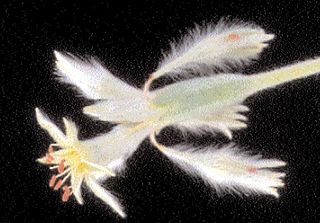
Eriogonum longifolium Nutt. var. gnaphalifolium Gand., commonly referred to as scrub buckwheat is a dicot of the Polygonaceae family. It is listed as threatened in the US and endangered in Florida. Within Florida its most closely related species is Eriogonum tomentosum however there are three other varieties of Eriogonum longifolium found in other areas of the US.
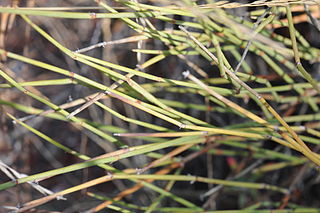
Ephedra trifurca is a species of Ephedra known by the common names longleaf jointfir and Mexican tea.

Eriogonum arborescens is a species of wild buckwheat known by the common name Santa Cruz Island buckwheat.
Eriogonum cinereum is a species of wild buckwheat known by the common names coastal buckwheat and ashyleaf buckwheat.
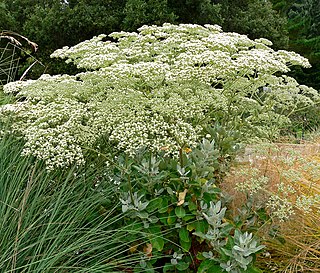
Eriogonum giganteum, with the common name St. Catherine's lace, is a species of wild buckwheat in Southern California.

Eriogonum ovalifolium is a species of wild buckwheat known by the common name cushion buckwheat. It is native to western North America from California to Alberta, where it is a member of many plant communities in varied habitats.
Eriogonum longifolium var. lindheimeri, commonly known as Lindheimer's long-leaf eriogonum and Lindheimer's buckwheat, is a dicot of the family Polygonaceae, found in New Mexico and Texas.

Eriogonum tomentosum, commonly referred to as dogtongue buckwheat or dogtongue wild buckwheat, is a species in the Polygonaceae family.
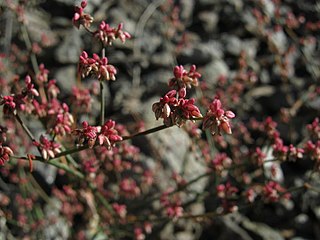
Eriogonum hoffmannii is a species of wild buckwheat known by the common name Hoffmann's buckwheat. It is endemic to Inyo County, California, where it is found only in the mountains around Death Valley; most of the known populations of the plant are located in Death Valley National Park. The plant grows in the desert scrub on the slopes of the Panamint, Black, and Funeral Mountains.

Eriogonum sphaerocephalum is a species of wild buckwheat known by the common name rock buckwheat. It is native to the western United States primarily east of the crest of the Cascade Range in Washington and Oregon to Idaho and from southern Oregon and northern California to northern Nevada. It is a common member of desert, rocky and sagebrush steppe habitats. Eriogonum sphaerocephalum is found over a wide range of elevations, but is most common between 2,000–7,000 feet (600–2,100 m).
Eriogonum gypsophilum is a rare species of wild buckwheat known by the common names Seven River Hills buckwheat and gypsum wild buckwheat. It is endemic to the state of New Mexico in the United States, where it is known from only three sites in Eddy County. It is limited to a specific type of soil which is high in gypsum. The plant has been federally listed as a threatened species of the United States since 1981.
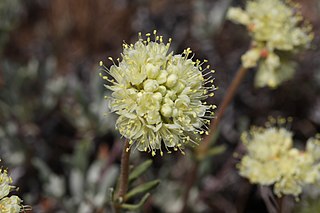
Eriogonum douglasii is a species of wild buckwheat known by the common name Douglas' buckwheat. It is native to the western United States, including the Pacific Northwest and part of the Great Basin.
Eriogonum diatomaceum is a species of wild buckwheat known by the common name Churchill Narrows buckwheat. It is endemic to Nevada in the United States, where it is known only from the Pine Nut Mountains in Lyon County. It is limited to the Churchill Narrows near Fort Churchill State Historic Park. This plant was discovered in 1997 and described to science in 2002.
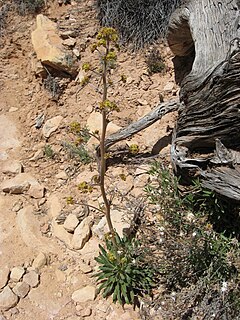
Eriogonum alatum, with the common names winged buckwheat and winged eriogonum, is a species of buckwheat.
Eriogonum zionis, common name Zion wild buckwheat or Point Sublime wild buckwheat, is a plant species native to the southwestern United States, the states of Utah and Arizona. It grows on sandy or gravelly soil at elevations of 1300–2300 m.















